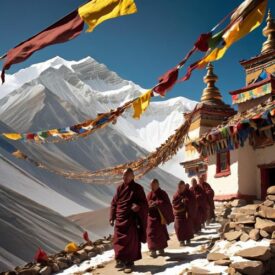South Asian Mythology
South Asian mythology represents one of the most diverse and spiritually profound mythological traditions in the world, encompassing the ancient tales of India, Nepal, Sri Lanka, Bhutan, Tibet, Pakistan, and Bangladesh. Rooted in centuries of shared history and cultural exchange, these myths explore cosmic creation, divine justice, human emotion, and the eternal relationship between gods and mortals. The region’s mythology is not confined to a single faith or language—it is a living mosaic shaped by Hinduism, Buddhism, Jainism, Islam, and countless local folk traditions. Every river, mountain, and temple carries a sacred story, and through these narratives, South Asian mythology continues to define how people understand divinity, destiny, and the deeper meaning of life.
At the heart of South Asian mythology lies a deep reverence for the interconnectedness of all things. From the great Hindu epics of India—the Ramayana and Mahabharata—to the Buddhist Jataka tales of Nepal and Sri Lanka, and the Bon-influenced legends of Tibet and Bhutan, these stories form a shared spiritual heritage. They tell of gods who walk among humans, heroes who rise from mortal struggles, and cosmic beings who sustain the universe through balance and compassion. Figures like Shiva, Vishnu, Tara, Avalokiteshvara, Ravana, and Guru Rinpoche transcend regional boundaries, appearing in different forms across nations and faiths. The symbolism of dharma (righteousness), karma (action), and moksha (liberation) runs through these myths, offering timeless moral and philosophical lessons that still resonate in modern life.
Each region of South Asia adds its own flavor and interpretation to this vast mythological landscape. In India, divine epics and Puranic lore form the foundation of spiritual life, while Nepal blends Hindu and Buddhist traditions in a seamless fusion of gods and Bodhisattvas. Bhutan and Tibet elevate the mysticism of Vajrayana Buddhism, filled with protector deities, compassionate Buddhas, and intricate cosmologies. In Sri Lanka, legends of King Ravana and guardian spirits intertwine with Buddhist teachings to express the island’s sacred identity. Even in Pakistan and Bangladesh, echoes of pre-Islamic Hindu and Buddhist traditions remain in folk songs, local deities, and ancient ruins that speak of a forgotten pantheon. This interconnectedness makes South Asian mythology a remarkable tapestry—diverse yet united, regional yet universal, constantly evolving yet timeless in essence.
Today, it continues to influence art, literature, cinema, and everyday spirituality across the world. From temple carvings and thangka paintings to Bollywood films and modern fantasy novels, ancient myths find new life and meaning. Festivals like Diwali, Vesak, and Losar bring these stories to life every year, reminding people of the eternal struggle between light and darkness, wisdom and ignorance. What makes South Asian mythology extraordinary is its ability to blend the sacred and the human—to celebrate the divine not as distant perfection but as an ever-present force within life itself. Through its gods, heroes, and cosmic cycles, it continues to guide, inspire, and connect generations across the vast spiritual landscape of the region.




